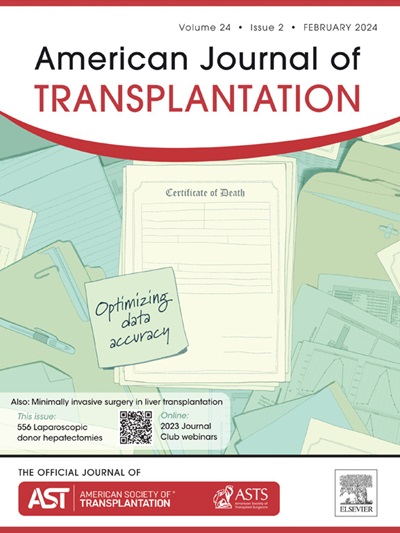Can Mouse Kidney Transplant Models Inform Mechanisms of Injury and Acceptance in Clinical Kidney Transplantation?
IF 8.9
2区 医学
Q1 SURGERY
引用次数: 0
Abstract
Despite standard of care immunosuppression, acute rejection remains commonly observed in kidney transplants and leads to chronic graft injury and failure in many transplanted patients. Mechanisms underlying acute and chronic kidney graft injury are incompletely understood, undermining development and implementation of therapeutic strategies to improve outcomes. This compels use of preclinical kidney transplant models to identify components and mechanisms mediating acute and chronic graft injury. Mouse models have been instrumental in establishing basic principles of alloimmune responses and rejection of heart allografts. There is increasing use of mouse models to extend these studies to kidney transplantation, but the relevance of the findings to clinical kidney transplants remains under scrutiny. Here, we discuss strengths and weaknesses of mouse models of kidney allograft responses and injury. Although obvious weaknesses arise when considering relevance to clinical kidney transplants, there are new models that recapitulate many features of kidney graft injury in the clinical scenario and have much to contribute to understanding innate and donor alloantigen-specific mechanisms underlying kidney allograft injury. As in most preclinical studies, the pertinent use of kidney allogeneic transplants in mice comes down to judicious choice of test questions and choice of appropriate donors and recipients for the chosen model.小鼠肾移植模型能否为临床肾移植损伤和接受机制提供信息?
尽管采用了标准的免疫抑制治疗,急性排斥反应在肾移植中仍然很常见,并导致许多移植患者的慢性移植物损伤和衰竭。急性和慢性肾移植损伤的机制尚不完全清楚,这破坏了改善预后的治疗策略的发展和实施。这迫使使用临床前肾移植模型来确定介导急性和慢性移植损伤的成分和机制。小鼠模型在建立同种异体心脏移植的同种免疫反应和排斥反应的基本原理方面发挥了重要作用。越来越多地使用小鼠模型将这些研究扩展到肾移植,但这些发现与临床肾移植的相关性仍在审查中。在这里,我们讨论了同种异体肾移植反应和损伤小鼠模型的优缺点。尽管在考虑与临床肾移植的相关性时存在明显的弱点,但有新的模型概括了临床场景中肾移植损伤的许多特征,并有助于理解肾移植损伤的先天和供体异体抗原特异性机制。与大多数临床前研究一样,在小鼠身上进行肾同种异体移植的相关使用归结为对测试问题的明智选择以及对所选模型的合适供体和受体的选择。
本文章由计算机程序翻译,如有差异,请以英文原文为准。
求助全文
约1分钟内获得全文
求助全文
来源期刊
CiteScore
18.70
自引率
4.50%
发文量
346
审稿时长
26 days
期刊介绍:
The American Journal of Transplantation is a leading journal in the field of transplantation. It serves as a forum for debate and reassessment, an agent of change, and a major platform for promoting understanding, improving results, and advancing science. Published monthly, it provides an essential resource for researchers and clinicians worldwide.
The journal publishes original articles, case reports, invited reviews, letters to the editor, critical reviews, news features, consensus documents, and guidelines over 12 issues a year. It covers all major subject areas in transplantation, including thoracic (heart, lung), abdominal (kidney, liver, pancreas, islets), tissue and stem cell transplantation, organ and tissue donation and preservation, tissue injury, repair, inflammation, and aging, histocompatibility, drugs and pharmacology, graft survival, and prevention of graft dysfunction and failure. It also explores ethical and social issues in the field.

 求助内容:
求助内容: 应助结果提醒方式:
应助结果提醒方式:


